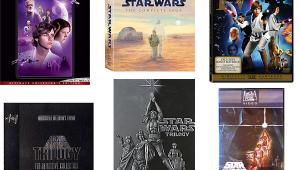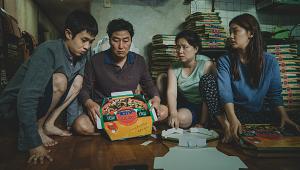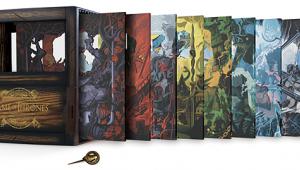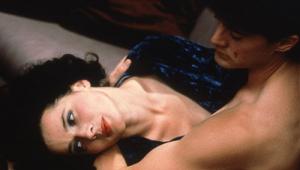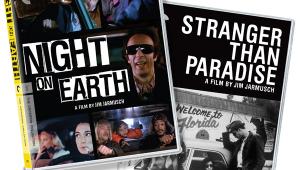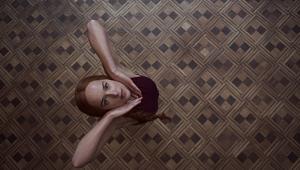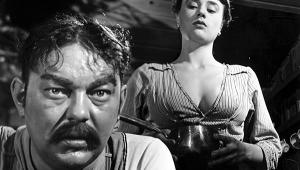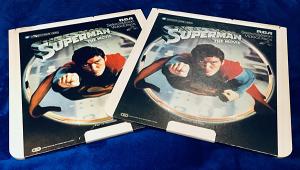Marvelous Monsters
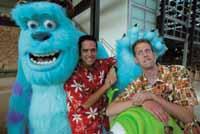
Also see: Measuring up Monsters
The atrium at Pixar Animation Studios is teeming with artists, animators, writers, and computer jockeys. Gliding past on Razor scooters or strolling off to the production studios and the render farms of high-speed computers used to make Pixar's pioneering animated films, they resemble the merry dwarfs in Snow White, the film that put feature animation on the map.
Last year's Monsters, Inc. was their most successful collaboration, reaping over half a billion dollars worldwide, second only to Disney's The Lion King in all-time box-office draw for animated films. More important, it represented a major leap forward in digital animation, taking it from a promising novelty to a significant contribution to the storytelling art.
Monsters is now poised to become an even bigger hit with its September 17 release as a $30 extras-filled, two-DVD set. I went to Pixar's whimsical, state-of-the-art facility just across the bay from San Francisco to see how the minds behind the monsters turned their digital creature feature into a reference-quality DVD.
The Plot Thickens
Among those scootering through the atrium one recent morning was Monsters, Inc. co-director Pete Docter. Clad in the kind of Tiki-themed shirt favored by Pixar's leading luminary, two-time Academy Award-winning director and animator John Lasseter, Docter stopped to talk about the elements that went into making the film such a hit. No. 1 on his list: the story.
Monsters centers on the friendship between James P. "Sulley" Sullivan, a blue- and purple-furred giant voiced by John Goodman, and his stumpy sidekick Mike Wazowski (Billy Crystal) - essentially an eyeball with legs. Together, they're the top scarers at a company that collects children's screams to provide the energy for the city of Monstropolis. Introduce a charming and resourceful toddler named Boo and a slithery scoundrel named Randall, and you have Docter's prescription for an engaging and heartwarming film.
It's plot, not pixels, that advances each Pixar effort, Docter told me. "With every film we raise the bar because the story gets just a little tighter, just a little more efficient. With Monsters, Inc., we have two characters who start out loving each other, and it's that friendship that's tested. When this little kid comes along, Sullivan goes through a journey of becoming a parent, a father figure to the kid, and all of his priorities change - which, as a parent, I know happens in real life."
Not that Docter discounts the digital wizardry that blew the virtual socks off moviegoers and critics alike - like Sulley's fur, which is so realistic it's a wonder animal-rights activists didn't insist on having an animal-safety guardian posted on location. "Traditionally, computer-generated animation does hard-surfaced stuff really well - a bottle, plastics, or a tabletop," Docter explained. "But things like fur, hair, even my hair," he said, touching his closely cropped coif, "are much more difficult. Sullivan's hair was pretty groundbreaking."
Going Deep
Computer-generated animation first caught the attention of the technology and entertainment worlds in the early 1980s. It was Apple Computer co-founder Steve Jobs, after all, who in 1986 bought the computer graphics division of Lucasfilm, Ltd. for $10 million to launch Pixar. His partner was Edwin Catmull, former head of the Lucasfilm division and a key developer of the RenderMan program, which creates realistic digital effects for computer graphics and animation. Today, Jobs is Pixar's CEO and Catmull is president.
John Lasseter, who two years earlier left his job as a Disney animator to do computer graphics at Lucasfilm, directed the venture's first feature, Toy Story, which earned him a special-achievement Oscar. Pixar's artists, led by Docter as animation supervisor, used computer-generated 3-D animation to enhance the believability of a world where toys had a life of their own. The studio introduced even more fluid movement and realistic modeling with A Bug's Life, enchanting audiences with facial expressions previously not possible using computers. And who can forget effects like the exquisitely plastic sheen of Bo Peep's "skin" in the Golden Globe-winning Toy Story 2?
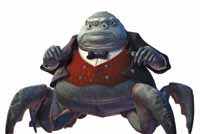 | |
His fellow Tiki-shirt wearer and co-director Lee Unkrich told me that technological advances in each of Pixar's films have contributed to the richness of animation on view in Monsters, Inc. "If you look at Toy Story, there was no depth of field whatsoever," said Unkrich, referring to the use of selective focus to create a sense of depth within a shot and to guide the viewer's eye. "There was a bit of depth of field in A Bug's Life, but not much because our software and hardware didn't have the power to pull it off."
Sharon Calahan's digital lighting work for A Bug's Life gave the film "a painterly feel that took it much farther away from the sterile feel of early computer animation," Unkrich said. "Her work on that film really inspired Jean-Claude Kalache and the others who did the lighting for Monsters."
Making Fur Fly
Figuring out the right structure for Sulley and how to make fur look natural on him were major challenges. "Pete saw both the skeleton and a taxidermy recreation of a prehistoric sloth at the Museum of Natural History in New York City," Unkrich recalled, "and it really inspired him to see how the bone structure worked inside the thing. The sloth was about the same size that he wanted Sulley to be. That was a turning point in coming up with Sulley's design and figuring out how he was likely to walk around."
As for the fur, said Unkrich, "once we looked at these sloths, and all kinds of textures of fur, and considered how different weights of fur reacted to wind blowing on them, it was just a matter of tackling the technical challenge and making it work."
Did that mean animating every individual piece of fur? "No, thankfully, because he has 2.3 million of them," Docter said. "We realized that it would just be craziness to try to do that, so we set up a computer program to simulate the fur. Since it's a dynamics program that reacts to the underlying structure of the character, the animators worked with a bald version of Sullivan."
That's the beauty of working in the realm of the fantastic, said Bill Kinder, senior manager of editorial and postproduction for Monsters, Inc. "This world we created certainly isn't realistic," he said, "so we're simply using the capability of computer-generated animation to create a tangible effect. And that effect is to make the audience feel that it can touch the surfaces, like the fur, which has a tactile quality, yet it's all completely fantastic."
Unkrich agreed. "The thing about making a movie about monsters is that you really can't do any research, right? So we came up with a child's interpretation of a monster by covering Sulley with blue and purple polka dots. If we had just covered him with brown fur, he would have been way too scary and wouldn't have had that playful quality he had."
That Kinder, Unkrich, and Docter all have children certainly made it easier for them to figure out what they were doing right and wrong with the film. "Our families are great sounding boards," Unkrich said. "For example, the opening of the movie used to be a lot scarier, with the whole monster coming out of the closet. But we could tell from showing it to our kids that it set a negative tone right from the get-go. They didn't want to watch the movie because they thought it was scary, so we toned that back a bit."
The three men's children also made a more direct contribution - by providing screams for the movie's soundtrack. "If you put a microphone in front of five-year-old kids and tell them to scream, they're not going to refuse," said Unkrich, with a laugh. Added Kinder, "One afternoon I brought in my boys - Henry and Jack - and they couldn't quite believe that we wanted them to scream, but they managed to get over that concern quickly enough."
Laserdisc 101
Unkrich, Docter, and Kinder are all big DVD fans and keenly aware of the format's possibilities, thanks to their student days spent watching laserdiscs. All three credit those platter-sized discs with advancing their film education and with imbuing them with a deep respect for crafting high-quality films and DVDs.
Docter recalled how watching laserdiscs helped him grow as a filmmaker. "I remember thinking, 'Now you can really study stuff frame by frame and unravel the mysteries of the ancients.' " And what does he consider a standout DVD? "I really like the Snow White one from Disney, and that's not just a corporate plug. I think it has really great information on it, and it's a historical film as well, so it's great to have it preserved and restored as well as it was."
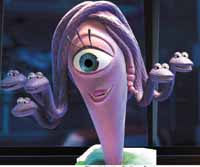 | |
"Now with DVDs, I'm convinced that for young people who want to get into filmmaking, they're the closest thing yet to having a conversation with a filmmaker they admire. Watching DVDs and laserdiscs has fed my instincts by allowing me to truly get inside the heads of filmmakers and figure out why they made the decisions they made."
Unkrich vividly remembers how listening to Martin Scorsese's commentary on the Raging Bull laserdisc helped him to advance his own thinking about moviemaking. "Scorsese talked a lot about films that influenced him. That enabled me to go out and watch those movies and understand how he was able to take ideas - it might just be the staging of a scene or a style of cinematography or the narration of the film - and then apply them to what he was working on," Unkrich said. "Up until that point, everything I'd ever learned about film came from watching movies or reading books. It was the first time I ever heard a director speak specifically about what he went through in making a film."
Kinder used to study videotapes, or he'd tape late-night independent TV and cut out the commercials. "When laserdiscs came along, it was sort of a dream," he said. "But you know, the whole having-to-flip-over-the-disc experience seemed to get in the way of enjoying the film. That's one reason I think DVD is a huge boon."
Digital Dexterity
Perhaps no one at Pixar has more reason than Kinder to be thankful for the digital link between computer-generated films and DVD. "I'm responsible for delivering the best master of the film we can on the various media. And with Monsters, Inc., I feel lucky that all of our images start digitally and land digitally on the discs that people take home. It's just a matter of hand-holding those pixels through the pipeline to make sure they look the way filmmakers want." To make the DVD, Kinder and his Pixar team took the digital frames and moved them onto a compressed digital video master, where they were color-corrected.
To satisfy both cineastes and casual viewers, the Monsters, Inc. DVD includes widescreen and full-screen versions on the same disc. "The full-screen version has been reframed, recomposed, and re-rendered," Kinder explained. "We literally went back to layout to create it. But it's worth the effort because otherwise you just can't get an acceptable image. Or an image might look fine on its own, but you lose the continuity with the next frame." But not everything had to be redone. "Some images can be cropped and survive. I don't know the exact number, but I think it's about a third, because it's expensive to re-render the entire show."
And why go through all the trouble of providing two versions? "Well, most people don't have a widescreen TV yet," Kinder said. "And we want those people to have access to a good version of the film."
Extras Special
The Monsters, Inc. discs provide all of the now-standard extras, and more. The most entertaining bonus is a short film created specifically for the DVD, Mike's New Car. The short lives up to the wonderful whimsy of the main attraction as Mike attempts to take Sulley for a spin in a souped-up sports car that under his control becomes a hazardous Rube Goldberg contraption. For an extra like this, the studio usually brings in "doubles" who mimic the voices of the original actors. But John Goodman and Billy Crystal are such big Monsters, Inc. fans that they agreed to do Sulley and Mike for the short as well.
Given the high reputation of all of the Disney/Pixar discs, I had to ask the creators what they thought constituted a reference-quality DVD. "I think 'reference quality' means making sure that the disc reflects the way we as filmmakers would like people to see our work," Docter said. "Because the film is going to live for years and years on DVD, we look at these discs as a chance to put down as much information as we can."
With Monsters, Inc., that meant including audio commentaries by Docter, Unkrich, Lasseter, and screenwriter Andrew Stanton. It also meant including a bevy of carefully crafted extras, cleverly divided between the Monster World and the Human World. The Monster World takes you inside Monstropolis, where you can go through a job orientation at the Monsters, Inc. plant under the watchful eye of archetypically gruff timecard maven Roz, watch "outtakes" from the movie, or play a game where you get to piece together Boo's shredded door. The Human World features an exhaustive look at the making of the movie from storyboard to finished film, a virtual tour of Pixar studios, and "flyarounds" of locations like the Monsters, Inc. factory and Boo's room. Other extras include Pixar's Oscar-winning short For the Birds.
"Monsters, Inc. represents the new high-water mark for DVDs because it includes not just a lot of extras, but a lot of creative extras that people really want to see," said Chris Carey, the senior vice president of worldwide DVD production and technical operations for Buena Vista Home Entertainment, which distributes Disney's home video and DVD products. "Another area where we moved the bar on Monsters is through games that you can play over and over again because they accept a variety of random responses." Having achieved this new level with the Monsters, Inc. DVD, where does the Disney/Pixar dream team plan to go next? Carey would like to see future releases include things that make the discs even more interactive, like sophisticated quiz and trivia extras aimed at families and kids.
Listen to the Mouse
Docter, Unkrich, and Kinder all agreed that the relationship between Pixar and Disney has been mutually beneficial. For instance, Kinder said the idea for Mike's New Car began with Disney. "Chris Carey mentioned it during a video conference call, and there was this collaborative epiphany that it would be great," Kinder said.
Docter and Unkrich both appreciate the critical eye that Tom Schumacher, president of Walt Disney Animation/Buena Vista Theatrical Group, brings to filmmaking. Unkrich points to the Abominable Snowman scene in Monsters, which proved particularly troublesome.
"We probably rewrote that 25 times, and even up to the very end with test audiences, that scene just wasn't up to the level of the rest of the film," he recalled. "Tom and the other folks at Disney helped us analyze why it wasn't working. They didn't tell us how to rewrite it, but we realized that the emotions of the scene just weren't coming through. So we went back and took one final stab at it and ended up with a version we're really happy with."
"The Disney team provides a great, objective eye, and they've done animation, well, forever, so we rely on their opinion and comments," Docter said. "And they play a huge part in releasing, distributing, and marketing the film."
In fact, the marketing campaign for Monsters, Inc. "will probably be our biggest one ever," said Bob Chapek, president of Buena Vista Home Entertainment - surpassing last year's massive campaign for the two-DVD set of Snow White that launched Disney's Platinum Edition series of classic films. It will also surpass the campaign for the second title in the series, Beauty and the Beast: Special Edition, which is slated for release October 8. "Beauty will be more than Snow White, and Monsters, Inc. will be bigger than Beauty," Chapek said.
While they could all comfortably rest on the considerable laurels garnered for having created one of the most successful movies of all time, the Monsters team seems eager to see exactly how far they can take digital animation. Lee Unkrich is already looking beyond Monsters to the challenges of the next Disney/Pixar feature.
"We haven't really done water in our films - there's a little bit of rain at the end of A Bug's Life, but not much water - and water has always been difficult to do with computer graphics," Unkrich said. "So what are we doing? We're making an entire film that takes place underwater called Finding Nemo. It comes out next year."
Unkrich declined to say much about Finding Nemo, but given the colossal box-office triumph of Monsters, Inc., it's a sure bet that there are a lot of people who can't wait to see what combination of story and techno-wizardry comes bubbling up from the deep.
Also see: Measuring up Monsters


